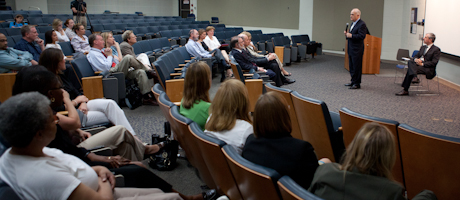By Jennifer Eder
Beginning July 1, the three schools that composed the GW Medical Center will operate as separate entities with different budgets, bylaws and development departments.
Under the new structure, the deans of the School of Medicine and Health Sciences, the School of Public Health and Health Services and the School of Nursing will report directly to Steven Lerman, provost and executive vice president for academic affairs. The deans will be responsible for creating bylaws, including tenure requirements, for their schools as well as running a budget for their staff and operations.
“This has been an incredibly collaborative process. I can’t thank the deans enough,” said Dr. Lerman during a town hall meeting earlier this week. “It is like an amicable but messy three-person divorce. It’s very complex. There are assets that need to be divided. There are things that need to be shared. And there are space issues. But everyone is working in good faith to move forward in the spirit of creating a new model that will then serve as a platform for us becoming yet a better medical area.”
The School of Medicine and Health Sciences and the School of Public Health and Health Services will operate on a “closed-budget model,” where the school keeps most of its revenue and pays for all of its services. The School of Nursing will operate on a “unified budget model,” where more of the revenue will fall into the main budget for the university but more of the school’s services will be provided by GW. Because the nursing school has only been open for a year, it does not yet have enough tuition revenue to operate on a closed-budget model, Dr. Lerman said.
Each school will have its own development and communication operations. However, all three schools will continue to contribute to Himmelfarb Library, which will be managed by the medical school, and will continue to collaborate on research and academic opportunities.
While the new structure will officially take effect in just a few weeks, Dr. Lerman said some of these processes are very complex and will take more time to separate the three schools into three distinct entities. It will take some additional time to separate the various accounts in GW’s financial systems and to work though the situations for more than 200 employees that work under the Medical Center.
The dean of the medical school will also manage the relationships with the George Washington University Hospital and the GW Medical Faculty Associates and have the title of vice provost for health affairs. The search for a permanent dean of the medical school will officially begin in the fall.
This new structure was recommended for consideration by a team of independent experts, who completed an organizational assessment based on more than 30 interviews with stakeholders during the first phase of the Medical Center review.
Dr. Lerman said this model has had the most support from students, faculty and staff throughout the entire review process.
“We’re all very excited because this new model will strengthen each school,” said Jeffrey Akman, interim dean of the medical school and vice provost for health affairs. “Each dean will have more authority, more ability to grow the research, faculty and academic programs.”
Lynn Goldman, SPHHS dean, said the school’s classes and laboratories will still be held in Ross Hall until the school moves into its new building, which will be located where the Warwick Building currently stands at Washington Circle. SPHHS will also be launching a strategic planning process on how to improve its academic programs and research efforts, Dr. Goldman said.
Jean Johnson, dean of the nursing school, said the school plans to keep a footprint on the Foggy Bottom Campus but will have most of its programs at the Virginia Science and Technology Campus. Dr. Johnson said the school continues to grow its enrollment and faculty.
The multiphase review was requested in May 2010 by the Medical Center Committee of the Board of Trustees in view of the approaching 10th anniversary of the creation of the center’s current structure, the changing conditions of the health care marketplace as a result of local competition and health care reform legislation and the university’s commitment to raising the center’s academic stature.
President Steven Knapp and Dr. Lerman held several town hall meetings over the past few months about the future of the structure of the three schools to gather feedback from stakeholders.
During the second phase of the review, the Medical Center Advisory Committee – composed of deans, students, faculty and senior administrative staff from the three schools, the GW Hospital and the MFA – examined the Medical Center’s governance, finances, academic and research resources and other services that are currently shared among the schools.
Dr. Knapp said the next phase of the review process will focus on the university’s partnerships with the GW Medical Faculty Associates and the GW Hospital as well as other entities in the Washington, D.C. area to partner in fundraising, research and recruitment efforts.


